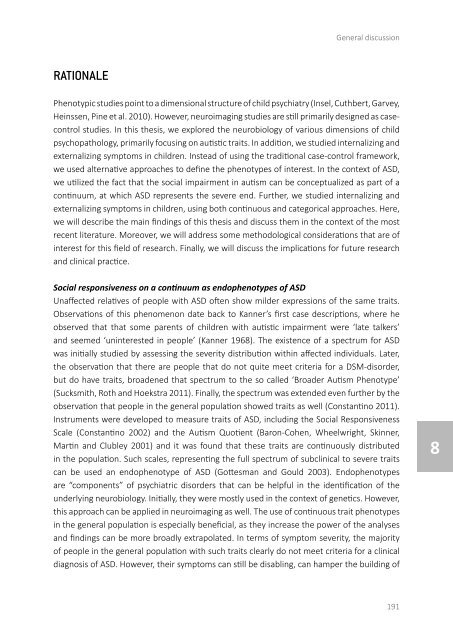On the Spectrum
2lm5UyR
2lm5UyR
You also want an ePaper? Increase the reach of your titles
YUMPU automatically turns print PDFs into web optimized ePapers that Google loves.
General discussion<br />
RATIONALE<br />
Phenotypic studies point to a dimensional structure of child psychiatry (Insel, Cuthbert, Garvey,<br />
Heinssen, Pine et al. 2010). However, neuroimaging studies are still primarily designed as casecontrol<br />
studies. In this <strong>the</strong>sis, we explored <strong>the</strong> neurobiology of various dimensions of child<br />
psychopathology, primarily focusing on autistic traits. In addition, we studied internalizing and<br />
externalizing symptoms in children. Instead of using <strong>the</strong> traditional case-control framework,<br />
we used alternative approaches to define <strong>the</strong> phenotypes of interest. In <strong>the</strong> context of ASD,<br />
we utilized <strong>the</strong> fact that <strong>the</strong> social impairment in autism can be conceptualized as part of a<br />
continuum, at which ASD represents <strong>the</strong> severe end. Fur<strong>the</strong>r, we studied internalizing and<br />
externalizing symptoms in children, using both continuous and categorical approaches. Here,<br />
we will describe <strong>the</strong> main findings of this <strong>the</strong>sis and discuss <strong>the</strong>m in <strong>the</strong> context of <strong>the</strong> most<br />
recent literature. Moreover, we will address some methodological considerations that are of<br />
interest for this field of research. Finally, we will discuss <strong>the</strong> implications for future research<br />
and clinical practice.<br />
Social responsiveness on a continuum as endophenotypes of ASD<br />
Unaffected relatives of people with ASD often show milder expressions of <strong>the</strong> same traits.<br />
Observations of this phenomenon date back to Kanner’s first case descriptions, where he<br />
observed that that some parents of children with autistic impairment were ‘late talkers’<br />
and seemed ‘uninterested in people’ (Kanner 1968). The existence of a spectrum for ASD<br />
was initially studied by assessing <strong>the</strong> severity distribution within affected individuals. Later,<br />
<strong>the</strong> observation that <strong>the</strong>re are people that do not quite meet criteria for a DSM-disorder,<br />
but do have traits, broadened that spectrum to <strong>the</strong> so called ‘Broader Autism Phenotype’<br />
(Sucksmith, Roth and Hoekstra 2011). Finally, <strong>the</strong> spectrum was extended even fur<strong>the</strong>r by <strong>the</strong><br />
observation that people in <strong>the</strong> general population showed traits as well (Constantino 2011).<br />
Instruments were developed to measure traits of ASD, including <strong>the</strong> Social Responsiveness<br />
Scale (Constantino 2002) and <strong>the</strong> Autism Quotient (Baron-Cohen, Wheelwright, Skinner,<br />
Martin and Clubley 2001) and it was found that <strong>the</strong>se traits are continuously distributed<br />
in <strong>the</strong> population. Such scales, representing <strong>the</strong> full spectrum of subclinical to severe traits<br />
can be used an endophenotype of ASD (Gottesman and Gould 2003). Endophenotypes<br />
are “components” of psychiatric disorders that can be helpful in <strong>the</strong> identification of <strong>the</strong><br />
underlying neurobiology. Initially, <strong>the</strong>y were mostly used in <strong>the</strong> context of genetics. However,<br />
this approach can be applied in neuroimaging as well. The use of continuous trait phenotypes<br />
in <strong>the</strong> general population is especially beneficial, as <strong>the</strong>y increase <strong>the</strong> power of <strong>the</strong> analyses<br />
and findings can be more broadly extrapolated. In terms of symptom severity, <strong>the</strong> majority<br />
of people in <strong>the</strong> general population with such traits clearly do not meet criteria for a clinical<br />
diagnosis of ASD. However, <strong>the</strong>ir symptoms can still be disabling, can hamper <strong>the</strong> building of<br />
8<br />
191


